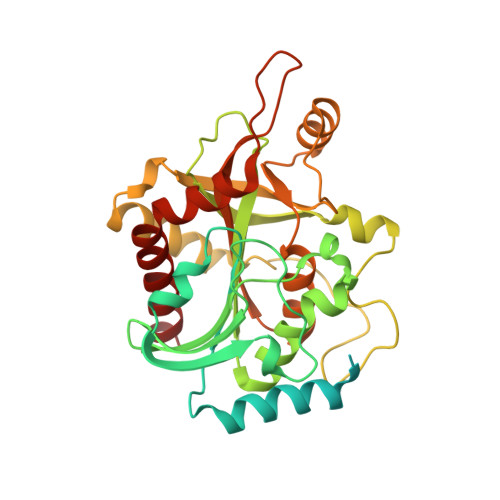Anopheles gambiae purine nucleoside phosphorylase: catalysis, structure, and inhibition.
Taylor, E.A., Rinaldo-Matthis, A., Li, L., Ghanem, M., Hazleton, K.Z., Cassera, M.B., Almo, S.C., Schramm, V.L.(2007) Biochemistry 46: 12405-12415
- PubMed: 17918964
- DOI: https://doi.org/10.1021/bi7010256
- Primary Citation of Related Structures:
2P4S - PubMed Abstract:
The purine salvage pathway of Anopheles gambiae, a mosquito that transmits malaria, has been identified in genome searches on the basis of sequence homology with characterized enzymes. Purine nucleoside phosphorylase (PNP) is a target for the development of therapeutic agents in humans and purine auxotrophs, including malarial parasites. The PNP from Anopheles gambiae (AgPNP) was expressed in Escherichia coli and compared to the PNPs from Homo sapiens (HsPNP) and Plasmodium falciparum (PfPNP). AgPNP has kcat values of 54 and 41 s-1 for 2'-deoxyinosine and inosine, its preferred substrates, and 1.0 s-1 for guanosine. However, the chemical step is fast for AgPNP at 226 s-1 for guanosine in pre-steady-state studies. 5'-Deaza-1'-aza-2'-deoxy-1'-(9-methylene)-Immucillin-H (DADMe-ImmH) is a transition-state mimic for a 2'-deoxyinosine ribocation with a fully dissociated N-ribosidic bond and is a slow-onset, tight-binding inhibitor with a dissociation constant of 3.5 pM. This is the tightest-binding inhibitor known for any PNP, with a remarkable Km/Ki* of 5.4 x 10(7), and is consistent with enzymatic transition state predictions of enhanced transition-state analogue binding in enzymes with enhanced catalytic efficiency. Deoxyguanosine is a weaker substrate than deoxyinosine, and DADMe-Immucillin-G is less tightly bound than DADMe-ImmH, with a dissociation constant of 23 pM for AgPNP as compared to 7 pM for HsPNP. The crystal structure of AgPNP was determined in complex with DADMe-ImmH and phosphate to a resolution of 2.2 A to reveal the differences in substrate and inhibitor specificity. The distance from the N1' cation to the phosphate O4 anion is shorter in the AgPNP.DADMe-ImmH.PO4 complex than in HsPNP.DADMe-ImmH.SO4, offering one explanation for the stronger inhibitory effect of DADMe-ImmH for AgPNP.
Organizational Affiliation:
Department of Biochemistry, Albert Einstein College of Medicine at Yeshiva University, 1300 Morris Park Avenue, Bronx, New York 10461, USA.
















